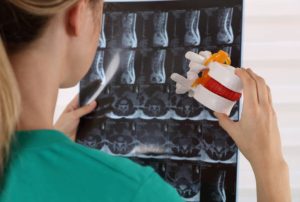Some discogenic pains cannot be cured. The following low back pain subgroups have been proposed:
Mechanically reducible discogenic back pain is defined as pain that responds to mechanical loading methods. However, patients who are insensitive to mechanical loading procedures are referred to as having nonreducible discogenic back pain.
Non-reducible discogenic pain (NRDP) is classified as follows:

- some ruptured outer annulus wall with or without radiculopathy.
- Discitis.
- A shaky [Unstable] disc.
- Other conditions such as endplate edoema (modic alterations) and central disc herniation (Schmoral’s nodes).
NRDP has been defined as discogenic pain that does not react to MLS in the absence of localised herniation or nerve root compression (McKenzie R., 1981; Petersen T. et al., 2003; Laslett M. and van Wijmen P., 1999). As possible mechanisms leading to the non-predictable nuclear migration observed during mechanical loading strategies, inflammatory processes in the disrupted annulus fibrosis (Adams MA, et al. 2010) or an incompetent annulus or non-functional hydrostatic mechanism (Donelson R, et al. 1997) have been proposed (Kolber MJ, and Hanney WJ, 2009). However, there has been little investigation into the clinical characteristics of NRDP.
So, what characteristics do doctors say are indicative of NRDP?

Despite the fact that this subgroup of discogenic pain shows a positive discogram finding, according to a 2013 study conducted by Chan AY and his colleagues, eight characteristics of NRDP were identified:
- There is no position or movement that decreases symptoms permanently.
- There is no long-term centralization of symptoms with any position or movement.
- Symptoms are peripheralized with all loading tactics, including repetitive movements and protracted positions.
- Loading tactics (i.e., repeated motions, persistent positioning, or posture) have little influence on presentation.
- Symptoms of constant pain.
- Symptoms worsen with all loading techniques (i.e., all movement orientations).
- Controlling symptoms is challenging.
- Increase in symptoms with randomly provocative and inconsistent positions and movements.
- There is little to no mobility loss.
References:
- Adams MA, Stefanakis M, Dolan P. Healing of a painful intervertebral disc should not be confused with reversing disc degeneration: implications for physical therapies for discogenic back pain. Clin Biomech 2010;25:961–71.
- Chan AY, Ford JJ, McMeeken JM, Wilde VE. Preliminary evidence for the features of non-reducible discogenic low back pain: survey of an international physiotherapy expert panel with the Delphi technique. Physiotherapy. 2013 Sep;99(3):212-20. Epub 2013 Mar 19.
- Donelson R, Aprill C, Medcalf R, Grant W. A prospective study of centralization of lumbar and referred pain. A predictor of symptomatic discs and anular competence. Spine 1997;22:1115–22.
- Kolber MJ, Hanney WJ. The dynamic disc model: a systematic review of the literature. Phys Ther Rev 2009;14:181–9.
- Laslett M, van Wijmen P. Low back and referred pain: diagnosis and a proposed new system of classification. N Z J Physiother 1999;27:5–14.
- McKenzie R. The lumbar spine: mechanical diagnosis and therapy. Waikanae: Spinal Publication; 1981.
- Petersen T, Laslett M, Thorsen H, Manniche C, Ekdahl C, Jacobsen S. Diagnostic classification of non-specific low back pain. A new system integrating patho-anatomic and clinical criterias. Physiother Theory Pract 2003;19:213–37.
